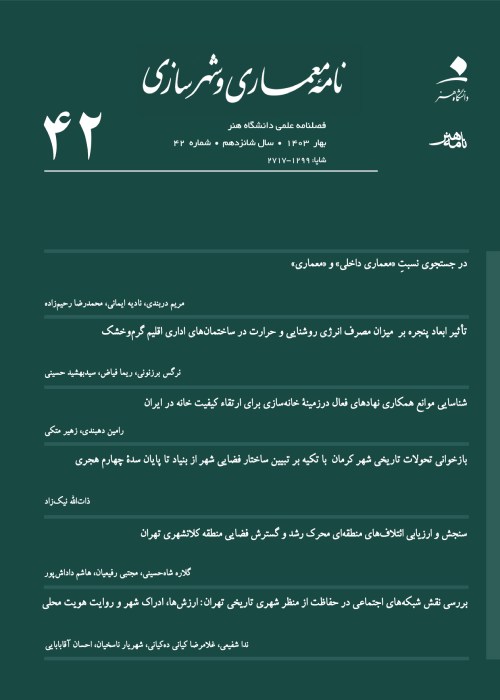Effective Factors in Promoting Sociability of Cultural Buildings Case Study: Farshchian Cultural Academy in Isfahan
Author(s):
Abstract:
With development of human societies and promotion of social needs for better living and limitations of residential space for some of them، the need for presence of social spaces becomes important. Human beings need to communicate with other، and this requires certain social spaces and in this respect، public spaces have different capabilities. However، this quality of space will not be possible without proper accountability to social needs in public spaces. Livable public spaces are generally attractive urban environments، which are highly active places and continuously visited by people during significant periods of the day. Generally، these spaces not only promote social gathering and interaction، but also invite a diversity of users and activities. Lack of such social spaces that satisfy the social needs and demands can be seen in urban spaces، especially in places which have been introduced for specific functions such as cultural، business، entertainment، services، buildings، etc. These spaces should be appropriate for providing social activities in addition to having the desired characteristics of a public space. In modern times with increased individualism، physical environment has become more important as the context of human activities in order for compensating social interactions partly، which has been lost in architectural and urban spaces and buildings. The problem of creating desired social interactions in architectural spaces and increasing its opportunities in public buildings by planners and designers underlies exploring types and levels of physical environment and its design process impact on this problem. Cultural spaces are regarded as part of public spaces that gather individuals within different spatial organizations voluntarily to perform cultural and social activities with other people. These spaces are proper places to make social interactions possible، which play an important role in creating، and reinforcing people interactions and communications with each other and with their social life. By understanding how to make social communication and its relationship with the surrounding environment، the architects and designers can be helped to properly design such spaces. This study aims to find relationships between spatial qualities and social implications including socialization. This study has two parts، review of literature in the field of sociability in public spaces that was conducted using library resources in the first part. The second part is based on the information obtained from users of the case study with a focus on cultural buildings activities that represents the linear-analytic type of case study، and follows the conventional research paper outlines، i. e. problem identification، literature review، methods، results، discussion، and conclusion. Thus، sociability was estimated based on the components of this case study through interviews and observation while the results were analyzed by investigating the spatial behaviors of users in maps. The results revealed that there is a direct relationship between the amount of socialization and physical and activity components of the built environment. These components can be effective، sometimes by themselves and sometimes in combination with each other، in the quantity and quality of socialization of public buildings. This study aimed to find relationships between spatial qualities and social implications including socialization. This study has two parts، Literature Review in the field of sociability in public spaces that were collected by using library resources in the first part. The second part is based on the information obtained from a case study users with a focus on cultural buildings activities that represents the linear-analytic type of case study، which follows the traditional research article outline: problem identification، literature review، methods، results، discussion، and conclusions. Thus، Sociability was estimated based on the components of this case study through interviews and observation while the results were analyzed by investigating the spatial behaviors of users in maps. The results revealed that there is a direct relationship between the amount of socialization and physical and activity components of the built environment. These components sometimes by themselves and sometimes in combination with each other can be effective in the quantity and quality of socialization of public buildings.
Keywords:
Language:
Persian
Published:
Journal of Architecture and Urban Planning, Volume:8 Issue: 15, 2015
Pages:
79 to 96
magiran.com/p1444480
دانلود و مطالعه متن این مقاله با یکی از روشهای زیر امکان پذیر است:
اشتراک شخصی
با عضویت و پرداخت آنلاین حق اشتراک یکساله به مبلغ 1,390,000ريال میتوانید 70 عنوان مطلب دانلود کنید!
اشتراک سازمانی
به کتابخانه دانشگاه یا محل کار خود پیشنهاد کنید تا اشتراک سازمانی این پایگاه را برای دسترسی نامحدود همه کاربران به متن مطالب تهیه نمایند!
توجه!
- حق عضویت دریافتی صرف حمایت از نشریات عضو و نگهداری، تکمیل و توسعه مگیران میشود.
- پرداخت حق اشتراک و دانلود مقالات اجازه بازنشر آن در سایر رسانههای چاپی و دیجیتال را به کاربر نمیدهد.
In order to view content subscription is required
Personal subscription
Subscribe magiran.com for 70 € euros via PayPal and download 70 articles during a year.
Organization subscription
Please contact us to subscribe your university or library for unlimited access!


